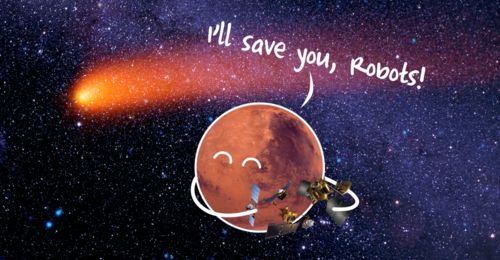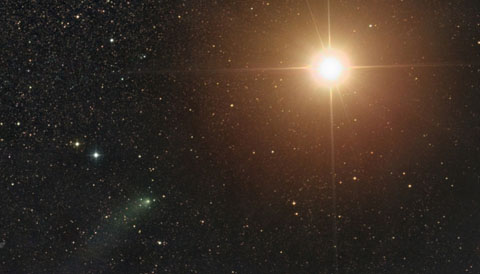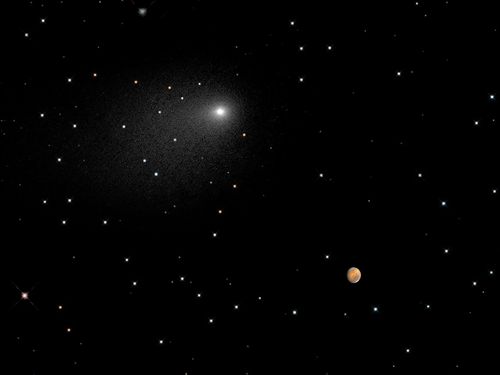NASA’s Hubble Space Telescope has produced a unique composite image of comet Siding Spring as it made its never-before-seen close passage of a comet by Mars.
Siding Spring, officially designated Comet C/2013 A1, made its closest approach to Mars at 18:28h GMT on 19th October 2014, at a distance of approximately 87,000 miles. That is about one-third of the distance between Earth and the moon. At that time, the comet and Mars were about 149 million miles from Earth.
The comet image is a composite of Hubble exposures taken between 18th October at 08:06h to 19th October at 23:17h. Hubble took a separate image of Mars at 22:37h on 18th October.
The Mars and comet images have been added together to create a single picture to illustrate the angular separation, or distance, between the comet and Mars at closest approach. The separation is approximately 1.5 arc minutes, or one-twentieth of the angular diameter of the full moon. The background star field in this composite image is synthesized from ground-based telescope data provided by the Palomar Digital Sky Survey, which has been reprocessed to approximate Hubble’s resolution.
The solid icy comet nucleus is too small to be resolved in the Hubble picture. The comet’s bright coma, a diffuse cloud of dust enshrouding the nucleus, and a dusty tail, are clearly visible.
This is a composite image because a single exposure of the stellar background, comet Siding Spring, and Mars would be problematic. Mars actually is 10,000 times brighter than the comet, so it could not be properly exposed to show detail in the Red Planet. The comet and Mars also were moving with respect to each other and could not be imaged simultaneously in one exposure without one of the objects being motion blurred. Hubble had to be programmed to track on the comet and Mars separately in two different observations.
NASA used its extensive fleet of science assets, particularly those orbiting and roving Mars, to image and study this once-in-a-lifetime comet fly-by. In preparation, NASA maneuvered its Mars Odyssey orbiter, Mars Reconnaissance Orbiter (MRO), and the newest member of the Mars fleet, Mars Atmosphere and Volatile EvolutioN (MAVEN), in order to reduce the risk of impact with high-velocity dust particles coming off the comet. Other NASA space observatories also joined Hubble in observing the encounter, along with ground-based telescopes on Earth.

Siding Spring is the first comet from our solar system’s Oort Cloud to be studied up close. The Oort Cloud, well beyond the outer-most planets that surround our sun, is a spherical region of icy objects believed to be material left over from the formation of the solar system.
The new composite image was taken with Hubble’s Wide Field Camera 3.
Last up, here's a picture of Comet Siding Spring taken from the Siding Spring Observatory in Australia where the comet was discovered, and from which the comet takes its name. It was taken by astrophotographer Damian Peach, using a robotic 20" telescope, and shows Mars (upper right) and Comet Siding Spring (lower left). As the comet is only Magnitude 12, Mars outshines it by about 10,000 times.

- Log in to post comments


